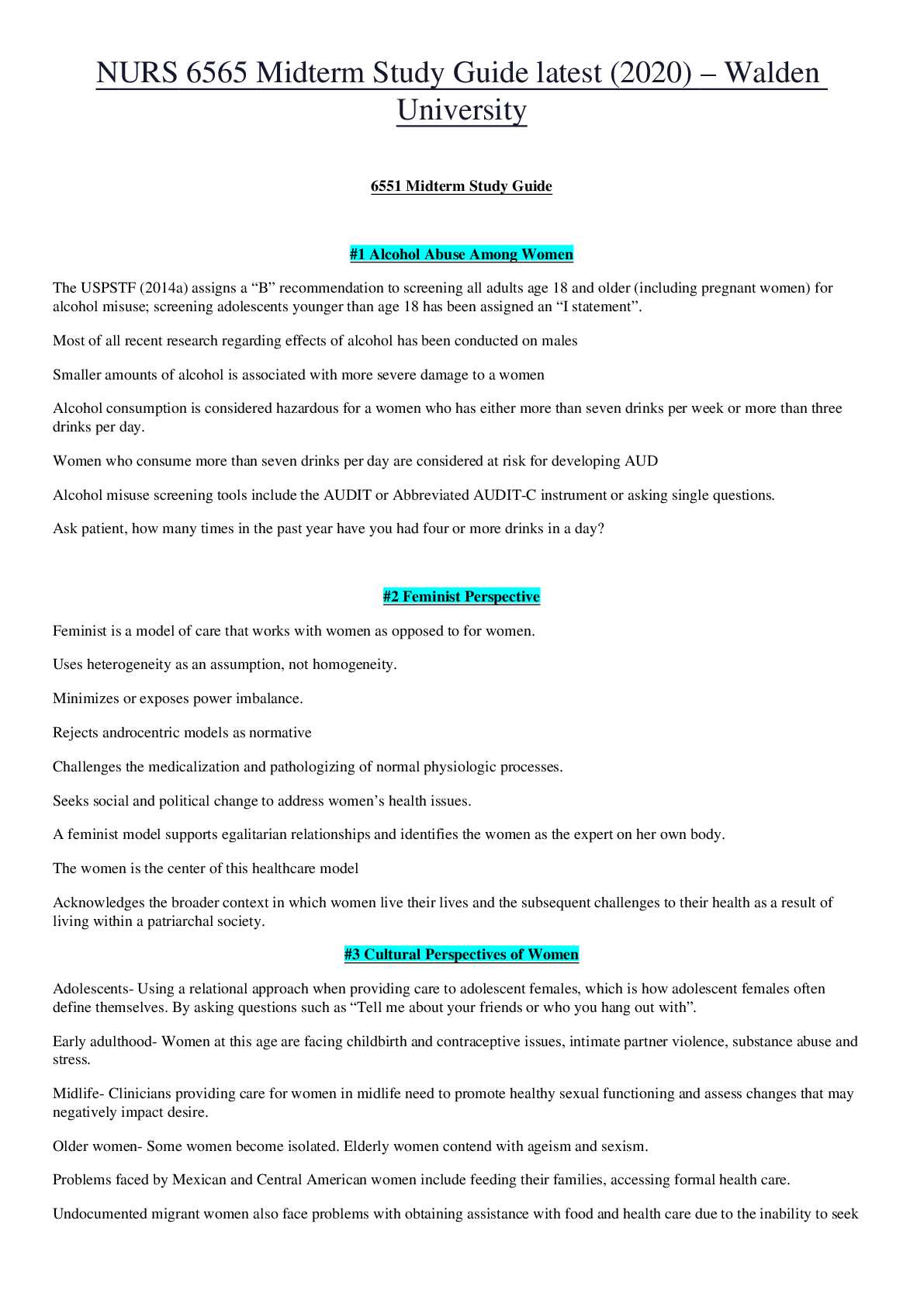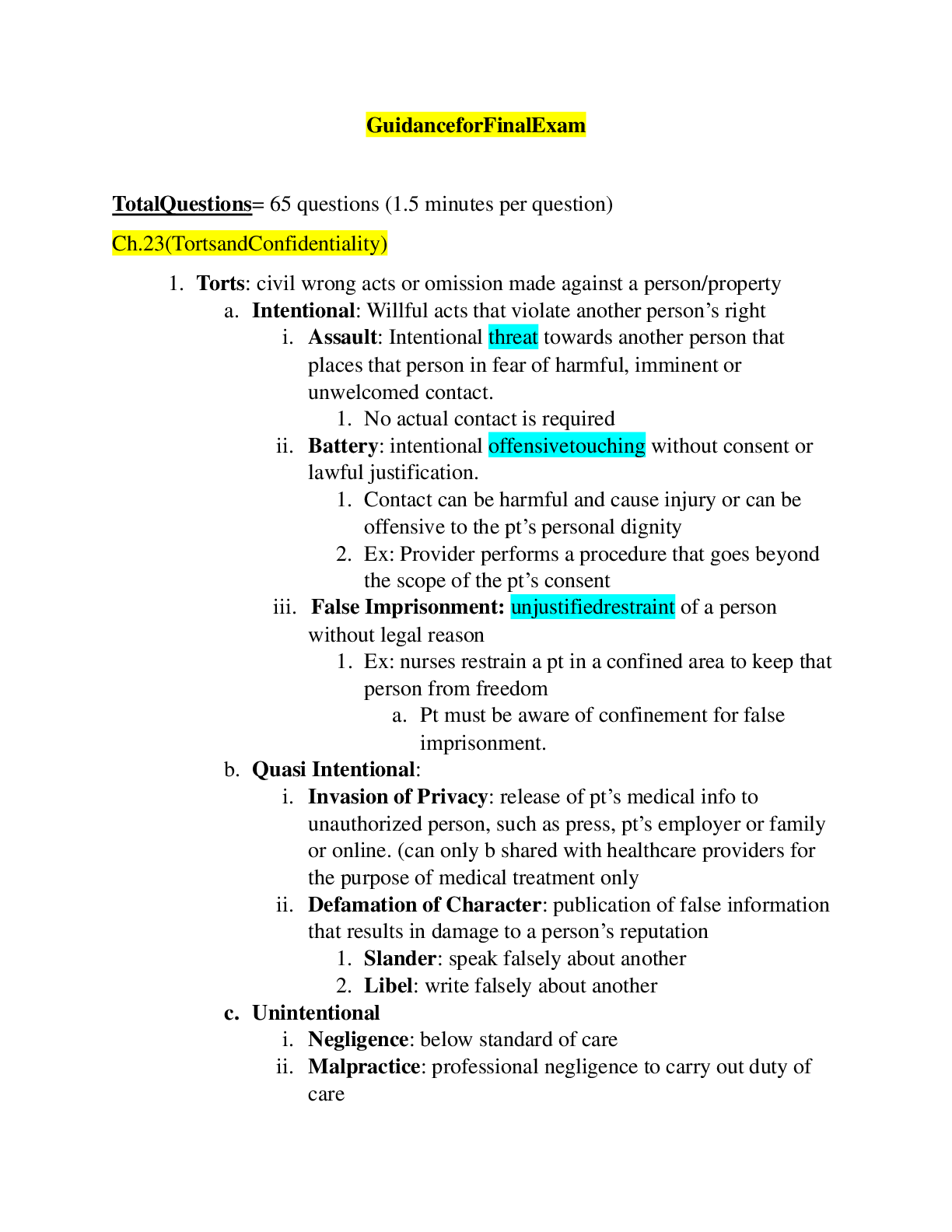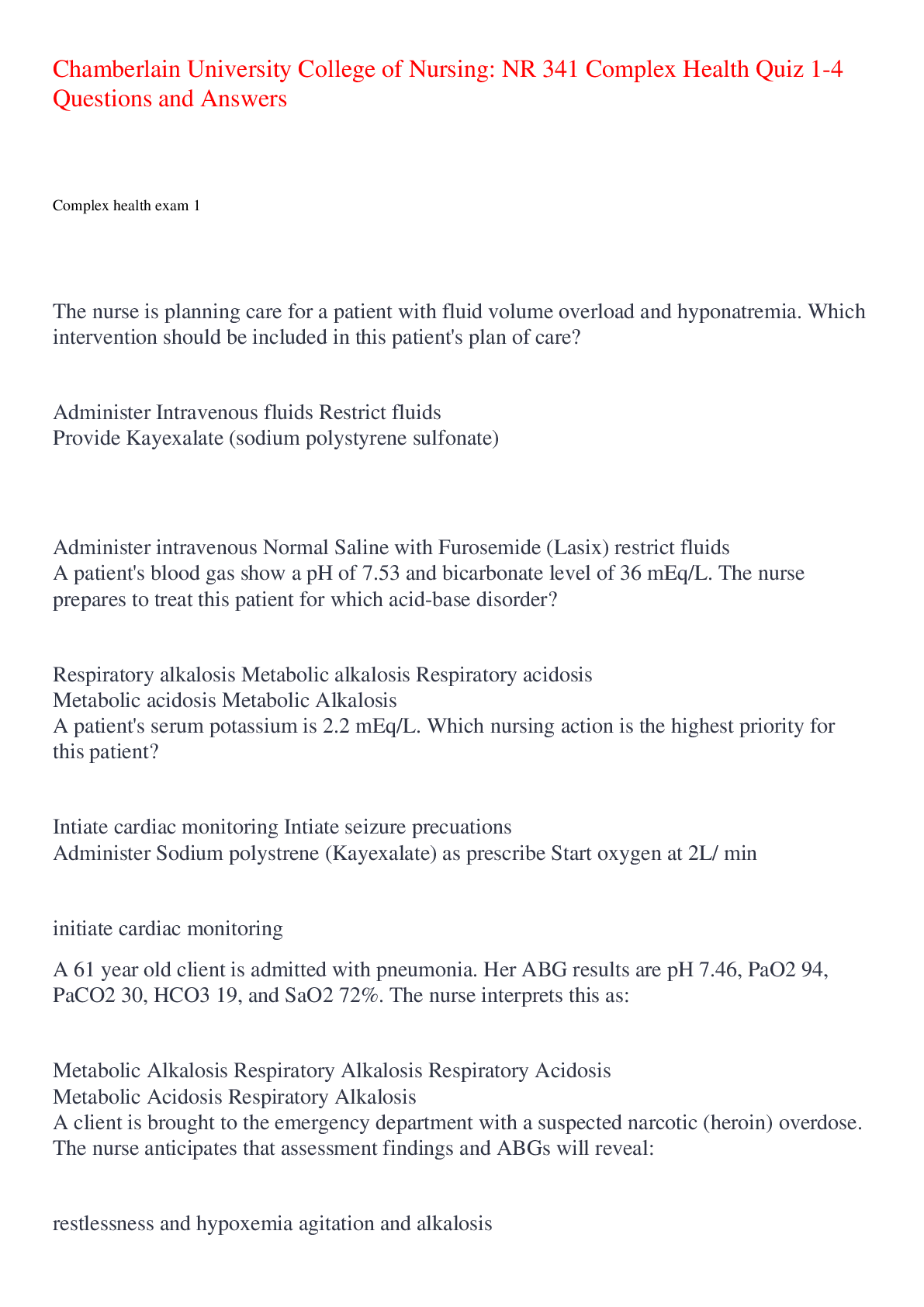*NURSING > EXAM > Chamberlain College of Nursing: NR 565 MidTerm Review_ LATEST 2021/2022,100% CORRECT (All)
Chamberlain College of Nursing: NR 565 MidTerm Review_ LATEST 2021/2022,100% CORRECT
Document Content and Description Below
Chamberlain College of Nursing: NR 565 MidTerm Review_ LATEST 2021/2022 MidTerm Review 1. G-Protien coupled receptors and how they interact with drugs G-protein coupled receptors (GPCR) in... teract with drugs through 7 regions of proteins that span and innervate the cell membrane, and trap the molecule into the receptor site like an interwoven basket (Insel & Sriram, 2018). Drugs can then enter this space and interact with the GRCP. A specific interaction and binding with a site on one or more of the regions of proteins within the GPCR, and drugs bound with the GRCP can stimulate the release of G proteins that can interact with various effector proteins to create physiological responses within the body (Insel & Sriram, 2018). This process occurs through secondary messengers (such as cAMP) which creates the extracellular interactions produced by the drug binding to the GRCP. 2. What neurotransmitters are excitatory? amino acids such as glycine, aspartate, and glutamate are excitatory (Woo & Robinson, p.16, 2016). 3. Which is the most common CYP enzyme in the body? What role does it play? According to the textbook, the CYP3A4 is the most important enzyme in the body. CYP3A4 is responsible for the metabolism of more than 50% of medications and is considered a major drug metabolizing enzyme. CYP3A4 can be found in the liver, as well as the lining of the GI tract. Due to this location, food can also influence this CYP. One example of this is grapefruit juice, which can inhibit CYP3A4. Medications that are metabolized by CYP3A4 include antimicrobials, calcium channel blockers, antihistamines, anticonvulsants, azole antifungals, and corticosteroids (Woo, & Robinson, 2016). 4. What is the clinical significance of being an ultra-rapid CYP2D6 metabolizer? People who are ultra-rapid metabolizers have high activity of CYP2D6 enzymes that break down certain medicines rapidly and are likely to need different doses or even a different medicine. Drug dose, response, and toxicity risk of beta-blockers, antidepressants, antiarrhythmics, and opioid analgesics are dependent on CYP2D6 pharmacogenetics (Ayazseven et al., 2020). Knowing the result of the CYP2D6 test and which group the patient falls into such as poor metabolizers, intermediate metabolizers, or ultra-rapid metabolizers, will help nurse practitioners prescribe the right medication and dosage for the patient. 5. What would be the concern if a drug is a CYP450indicer? How that might affect the metabolism of other drug the patient is taking? Cytochrome P450 enzymes are in cells throughout the body, primarily found in liver cells (Girvan & Munro, 2016). These enzymes are essential for the metabolism of many medications. Cytochrome P450 enzymes can act as an inducer or inhibitor of metabolism. When a medication induces the CYP450 enzyme that increases the rate of metabolism (Girvan & Munro, 2016). This can impact the effectiveness of other medications. For example, medication A induces CYP450 enzyme activity, therefore medication B will be metabolized quicker and have a less therapeutic effect. 6. Explain the significance of a drug being an inhibitor of P-glycoprotein? (see text) P-glycoprotein (P-gp) is the main barrier of the body and it affects the proper delivery of drugs and causes drug resistance in our body. P-gp is an efflux membrane transporter, that can be found throughout the body and it controls the cellular uptake and the distribution of synthetic substances, chemicals, and toxins. Drugs are chemicals and P-gp hinders the absorption, permeability, and retention of the drugs, extruding them out of the cells. This adversely affects drug therapies and fails to yield good results, for example in therapies like using chemo agents in cancer treatments. In this case, proper inhibition of P-gp is important to increase cellular uptake, transport, and half-lives of drugs. The drug is an inhibitor of P-gp that would help in the cost-effective treatment for disease conditions without wasting an extra amount of medicines. It will help to shorten the treatment time and speedy recovery of the patient (Abebe et al., 2019; Woo & Robinson, 2016). 7. Significance of a VCORC1 mutation for patients taking warfarin? In 2008, the U.S Food and Drug Administration updated the dosing of warfarin to include the application of pharmacogenomics. Variable metabolism by CYP2C9 was once known as the major contributor to the variable response to warfarin. However, a mutation in VCORC1 has been found to account for much more variability in warfarin responses and can cause a rare syndrome of warfarin resistance. A mutation in VCORC1 encodes a subunit of the vitamin K epoxide reductase complex ,the pharmacological target for warfarin, and increases the chances of uncontrolled bleeding (Woo & Robinson, 2016). Therefore, if providers have information about the presence of this mutation, they may decide to decrease the dosage of Coumadin for their patient. 8. What out text has to say about National Standards of Culturally and Linguistically Appropriate Services? In 2012, the institute of medicine identified that the main factor affecting health disparity is cultural competency of the health practitioner (Woo & Robinson, 2016). The National Standard for Culturally and Linguistically Appropriate Services in health and health care (CLAS) standards were created as a way to address and correct these inequities (Woo & Robinson, 2016). Originally established in 2000, the CLAS standards provided a blueprint for providers to implement services that were culturally and linguistically appropriate, however, over the years they have evolved (Woo & Robinson, 2016). They have undergone review and have been revised in 2013 and will continue to evolve in response to research and changing demographics (Woo & Robinson, 2016). 9. What are some differences in drug metabolism in Asian populations? One of the biggest differences in drug metabolism derives from the fact that Asian populations typically have reduced activity of the CYP450 2D6 and 2C19 enzymes (Woo & Robinson, 2016). Specifically, the 2D6 isoenzyme is responsible for metabolism of antiarrhythmics, antidepressants, and neuroleptics so the metabolism of these drugs are slower than other racial groups (Woo & Robinson, 2016). Given that, the clinician would need to make sure they monitor this patient and adjust dosages as appropriate. The 2C19 isoenzyme is responsible for metabolism of acids, bases, and neutral drugs (Woo & Robinson, 2016). Similarly to the 2D6 discussion above, these drugs may need lower dosages due to the slower metabolism of them. The text also discusses that some Asian subgroups are considered "fast acetylators" of drugs such as psychotropic and cardiac medications (Woo & Robinson, 2016). One of the most common drugs, Warfarin, may also be affected in that the Asian population may need lower doses due to the CYP 2C9 gene and VKORC1 gene (Woo & Robinson, 2016). Additional medications that this population may need lower doses of include beta-adrenergic blockers, ACE inhibitors, calcium channel blockers, and immunosuppressants (Woo & Robinson, 2016). 10. According to out text and U.S office of Minority Healthy, what are reasons for poor health outcome among African American? Chapter 7 in our text discusses many recognized health disparities in the United States. According to U.S. Department of Health and Human Services Office of Minority Health (2019) African Americans have a higher death rate than whites for "heart disease, stroke, cancer, asthma, influenza and pneumonia, diabetes, HIV/AIDS, and homicide (para. 5). Some of the disparities observed among African Americans in this country are a lower level of education, higher unemployment rates, lower income levels, having more hazardous occupations, family dynamics, less employee-sponsored health insurance, and lower immunization rates (Woo & Robinson, 2016). These things can lead to a lack and/or understanding of available resources for this minority group. Their health outcomes are poorer due to not seeing a health care provider regularly and not receiving proper care to prevent disease and health conditions. It is important for the nurse practitioner to be aware of health disparities for different groups that they will be treating. By understanding barriers to people receiving the care they need and deserve, we can help to reduce and hopefully someday eliminate these disparities. 11. Which pharmacokinetic factors exhibit racial differences? Pharmacokinetics is the study of how the body affects the drug. Pharmacokinetics has four phases and they are absorption, distribution, metabolism, and excretion, (Woo & Robinson, 2016). The pharmacokinetic factors that can exhibit racial differences include the bioavailability for drugs that undergo gut or hepatic first-pass metabolism, protein binding, volume of distribution, hepatic metabolism, and renal tubular secretion, (Woo & Robinson, 2016). Factors not expected to exhibit a difference involve absorption, filtration at the glomerulus, and passive tubular reabsorption, (Woo & Robinson, 2016). 12. Phase I and II metabolism Phase I metabolism involves non-synthetic reactions. Oxidation, reduction, and hydrolysis reactions prepare molecules for further metabolic reactions. Metabolites are rapidly eliminated during this phase. Remaining metabolites continue onto phase II reactions. This is the synthetic or conjugation reactions. During this phase, molecules are metabolized and another molecule, such as glucuronic acid, glycine, sulfate, or acetate is added to become a compound. This allows the kidneys to secrete the molecules easily because they become more water soluble. 13. What is the significance of VCORC1 mutation? The significance of the VCORC1 mutation is that it is related to an individual exhibiting warfarin resistance since it plays a role in metabolizing the drug warfarin (Woo et al., 2016). This means that the individual is prone to an increased risk of bleeding which can lead to adverse outcomes for the individuals who exhibit this genetic mutation (Fereidouni et al., 2019). The VCORC1 mutation is responsible for producing a “subunit of the vitamin K epoxide reductase complex” (Woo et al., 2016). It is currently not required by the FDA to complete genetic testing prior to starting warfarin, but as practitioners we should encourage our patients to complete genetic testing so that we can accurately calculate the correct dosage for warfarin without creating significant adverse outcomes for these individuals. 14. Can you describe how new drugs are developed from the text? New drugs are developed by researches in a lab first by looking into disease processes and the medications that are used to help treat these disease processes. After looking at the medications to help treat disease better, researches look into how to make the medications be more effective with less toxicity or 'side effects'. in order to do this, researchers start preclinical research. During this phase researchers look into whether the drug is going to kill people or cause serious harm to people. then they go into the clinical phase. The clinical phase is where they use the preclinical phase data and come up with human research subjects. These usually consist of two groups (one getting the new medication and one getting a 'fake' medication (placebo). Then this leads to step 4 the FDA drug review where they come up with labels, safety updates, etc. Then they move on to the post market monitoring where they actually pay attention to the way the medication is being used and what for. (US Food and Drug Administration, 2018) 15. Explain what it means if a drug is an antagonist? An antagonist according to our text is a drug that takes over a receptor without stimulating that receptor. We see the medication blocking the response of an agonist to that receptor. Such as seen in a beta-blocker keeping the adrenergic nerve activity from increasing the heart rate and therefore able to help decrease the heart rate of the patient taking the medication. Antagonists can make the agonist appear less potent. The effect of the antagonist depends on that of the affinity for the receptor and the blood levels noted in the patient (Woo RN PhD ARNP CPNP-PC CNL FAANP, Teri Moser et al., 2015). Another example would be naltrexone. This medication is used in patients that want to not relapse in heroin or opioid usage. The medication blocks the receptors for the opioids and does not allow the drugs to connect to the receptors. The problem with this is that it can cause an overdose if there is a relapse (Pharmacological Treatment | Medication Assisted Recovery, n.d.). 16. What the terms efficacy and bioavailability mean? According to Woo & Robinson (2016), efficacy in medicine means the power of producing the maximum effect of a drug (Woo & Robinson, 2016, p. 14). When thinking about efficacy and medication, an example may include hypertension medication and how it lowers blood pressure but can also have an effect on other mechanisms in the body such as heart rate or kidney function. Patients who are prescribed new medication should be monitored closely on how it may affect the patient’s outcome. It also states that drugs with higher efficacy can produce more significant effects than lower efficacy drugs (Woo & Robinson, 2016, p.14) Bioavailability refers to the extent of a substance or a drug that becomes available to its intended biological destination in pharmacology. Therefore, bioavailability measures the rate and fraction of the initial dose of a medication that successfully reaches either; the site of action or the bodily fluid territory from which the drug’s intended targets have unimpeded access. The text gave an example of and 500mg oral dose of ciprofloxacin that can be substituted for a 400mg IV dose of ciprofloxacin, which makes up about 80% of its oral availability (Woo & Robinson, 2016, p.19). 17. What are potential adverse effects associated with BBs according to the text? What lab abnormalities can occur? According to the text, there are several potential adverse effects for beta blockers (BB’s), and the text classifies them according to each body system, which I will outline for discussion purposes here as well. For the CV system, BB’s can cause hypotension, bradycardia, and CHF without pulmonary edema. In the respiratory system, BB’s may lead to bronchospasm and dyspnea, which is why they are used in precaution for patients with bronchospastic disorders such as asthma (Woo & Robinson, 2016). Fatigue, weakness and dizziness are all CNS effects that may occur secondary to hypotension, and anxiety, depression, drowsiness, nightmares and insomnia may occur in BB’s with high CNS penetration, or in older adults (Woo & Robinson, 2016). BB’s can also cause instability in blood glucose levels, especially for patients with diabetes due to alterations in carbohydrate metabolism. Changes in GI motility can lead to anorexia, N/V or constipation (Woo & Robinson, 2016). In the GU system, BB’s may cause impotence and decreased libido, which can be a reason for medication noncompliance. Less common reactions include myalgias, skin rashes, and facial edema (Woo & Robinson, 2016). Lab abnormalities associated with BB’s include elevated uric acid levels, BUN, serum lipoprotein, potassium and triglycerides (Woo & Robinson, 2016). Glucose levels may be increased or decreased, and ANA titers may also be increased (Woo & Robinson, 2020). 18. Why do BBs, and clonidine require tapers when discontinuing them? Abruptly stopping certain medications such as beta-blockers and clonidine without gradually tapering down the dosages can lead to withdrawal syndromes. Discontinuing cardiovascular drugs like propranolol and clonidine can result in rebound hypertension and increases the risk of cardiovascular events. If a patient taking clonidine suddenly stops taking it, his or her blood pressure will spike dangerous and can even cause a stroke (Akram et al., 2020). Other withdrawal symptoms from clonidine can include nervousness, headache, and tremors (Akram et al., 2020). Similarly, suddenly stopping propranolol or other beta-blockers can cause a spike in blood pressure as well as tachycardia that can even lead to chest pain and potentially a heart attack (Akron et al., 2020). 19. What are the effects of stimulation of beta 2 receptors? According to our text, Beta 2 receptors are located in the smooth muscle of the venules, bronchioles, liver, GI & GU systems, eyes, and pancreas. When stimulated, they increase cAMP, adenylyl cyclase, and activate cardiac G1. The results of stimulation are by system are relaxation of far vision for the eyes, dilation of the arterioles for skeletal muscle, dilation of pulmonary arterioles, dilation of systemic veins, relaxation of bronchial muscle, increased secretion in bronchial glands, decrease in GI motility, gluconeogenesis in the liver, increased secretion of insulin from the pancreas, relaxation of the urinary bladder, and smooth muscle relaxation in the uterus (Woo, & Robinson, 2016). 20. Another concern of BBs is the risk of bronchospasm 21. Considering ACEIs: what labs require monitoring? What can happen to potassium levels? Are they safe for young women who could be pregnant? ACE inhibitors require practitioners to monitor comprehensive metabolic panel (CMP) or basic metabolic panel (BMP) because this medication causes the body to "potentially retain potassium and impair kidneys if used incorrectly" (Raebel, et al., 2007). In pregnant patient it is a category C in the first trimester and D in the following trimesters. According to the Center for Drug Policy (2006) it is only recommended to take this medication while pregnant if the benefit outweighs the risk to the infant. 22. choose a topic from the study outline to discuss for your faculty response? The topic that I would like to discuss that can relate to this scenario is Beta-adrenergic antagonists/blockers. According to Mayo Clinic Beta blockers cause your heart to beat more slowly and with less force, which lowers blood pressure. Beta blockers also help open up your veins and arteries to improve blood flow. Beta blockers are used to prevent, treat or improve symptoms in people who have irregular heart rhythm (arrhythmia), heart failure, chest pain (angina), heart attacks, migraine, and certain types of tremors. The drugs that are well known to be beta blockers are the "lol" like metoprolol, atenolol and nadolol which are a few in that category. 23. choose a topic from the study outline to discuss for your faculty response? Muscarinic agonists mimic the action of acetylcholine on muscarinic receptors. Found on the postsynaptic cell membrane of smooth muscle, cardiac muscle, and exocrine gland cells, muscarinic receptors are activated by acetylcholine. This activation causes cardiac slowing, contractions of smooth muscles, and increase secretion from exocrine glandular tsues. There are two groups of muscarinic agonists, direct and indirect. Both indirect and direct agonists increase acetylcholine concentration in the synapse, which allows the effects acetylcholine on that receptor to be prolonged. Direct agonists, such as bethanechol, resist acetylcholinesterase, preventing its breakdown while producing its pharmacological effect by receptor activation. Indirect agonists, such as Neostigmine, inhibits the acetylcholinesterase enzyme preventing the breakdown of acetylcholine (Bui & Duong, 2019). 24. Can you choose a topic from the study outline to discuss for your faculty response? Adrenergic antagonists are categorized based on whether they block alpha receptors or beta receptors. Alpha-blockers can then be further categorized by their mechanism of action whether it be selective or non-selective. Alpha-1 receptors are found in the smooth muscle of the peripheral blood vessels as well as the smooth muscle of the prostate and urethral sphincter (Woo & Robinson, 2016). Alpha-1 antagonists can be used for conditions such as hypertension and benign prostatic hyperplasia (BPH). Alpha-1 antagonists can be identified by the ending in “osin” these medications include Prazosin, Doxazosin, Terazosin, Tamsulosin, Alfuzosin, and Silodosin (Woo & Robinson, 2016). 25. Can you choose a topic from the study outline to discuss for your faculty response? In week three’s study outline we were presented with drugs that affect the autonomic nervous system. Centrally Acting Alpha Adrenergics such as Clonidine can affect the autonomic nervous system. According to Woo and Robinson (2016) the activation of central alpha2 receptors results in the inhibition of cardioacceleration and vasoconstriction centers in the brain. This results in a decrease in peripheral outflow of norepinephrine causing decreased heart rate, peripheral resistance, blood pressure and renal vascular resistance. According to Woo and Robinson (2016) these medications are used largely as a second or third line of treatment for mild to moderate hypertension. Regarding pharmacokinetics, clonidine is easily absorbed from the GI tract and the skin and can easily enter the brain from absorption. Clonidine may also cross the placenta and be found in breast milk (Woo & Robinson, 2016). The liver in different degrees metabolizes the drug and the kidney is the organ of excretion. Woo and Robinson (2016) reports that cautious use is recommended in patients with severe coronary insufficiency, recent MI and renal function impairment. Clonidine should be avoided in patients with a history of bradycardia. According to the U.S FDA (2019) common side effects include dizziness, dry mouth, upset stomach and feeling tired. According to Woo and Robinson (2016) side effects may also include urinary retention, bradycardia, hypotension and chest pain. These side effects are key patient educational points and to report these to the provider in addition to taking these drugs as directed. [Show More]
Last updated: 1 year ago
Preview 1 out of 15 pages
Instant download
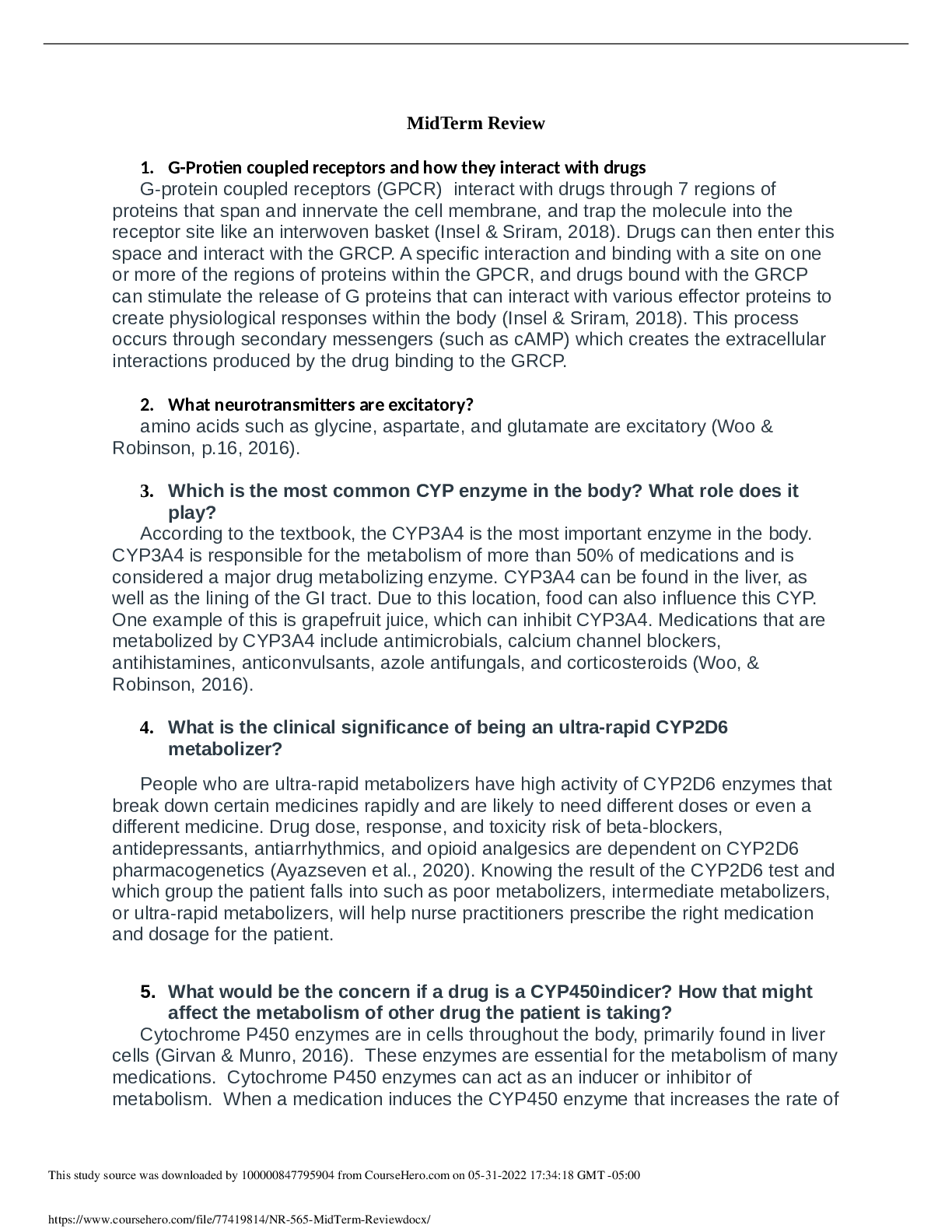
Instant download
Reviews( 0 )
Document information
Connected school, study & course
About the document
Uploaded On
Mar 05, 2022
Number of pages
15
Written in
Additional information
This document has been written for:
Uploaded
Mar 05, 2022
Downloads
0
Views
44

















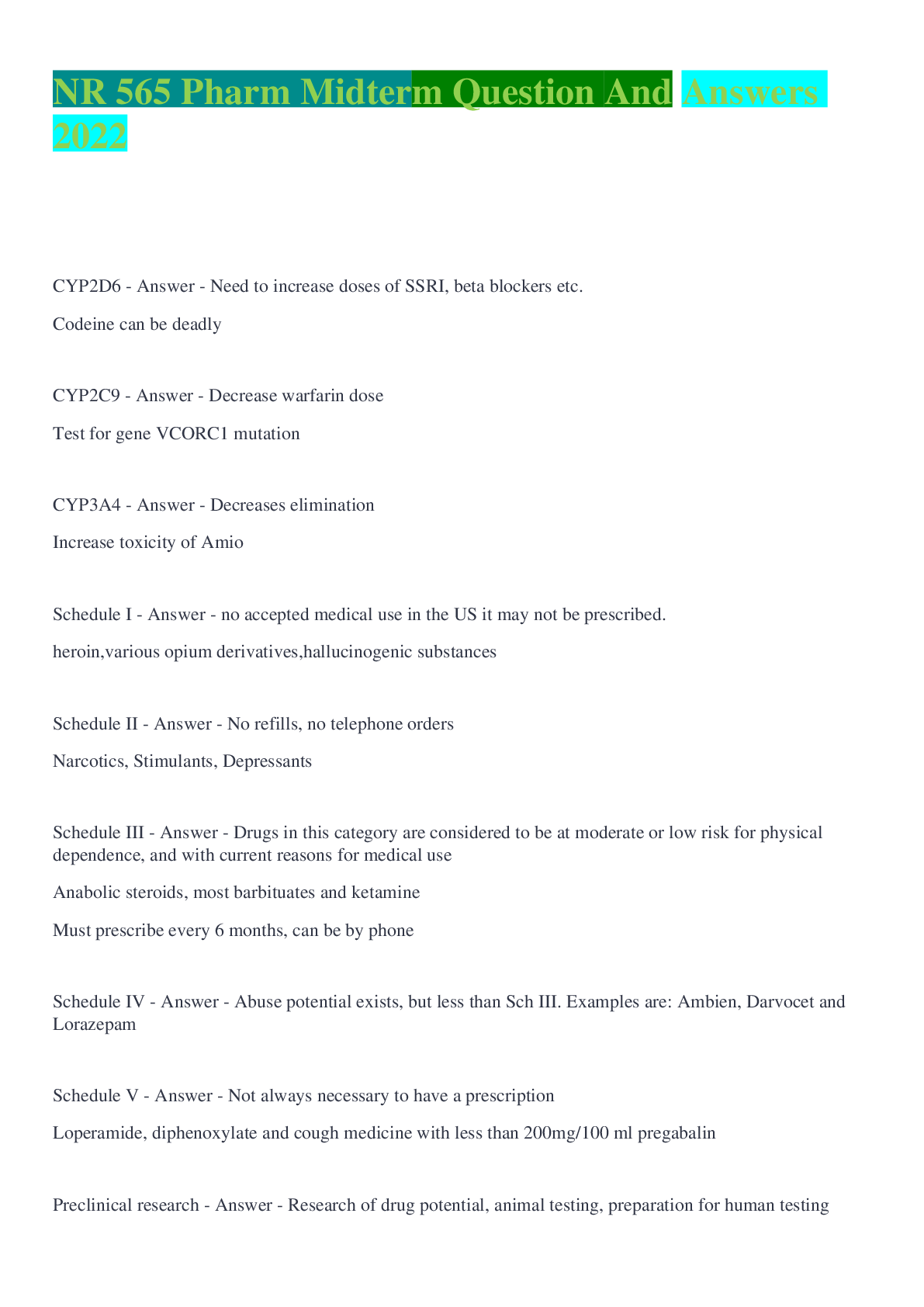
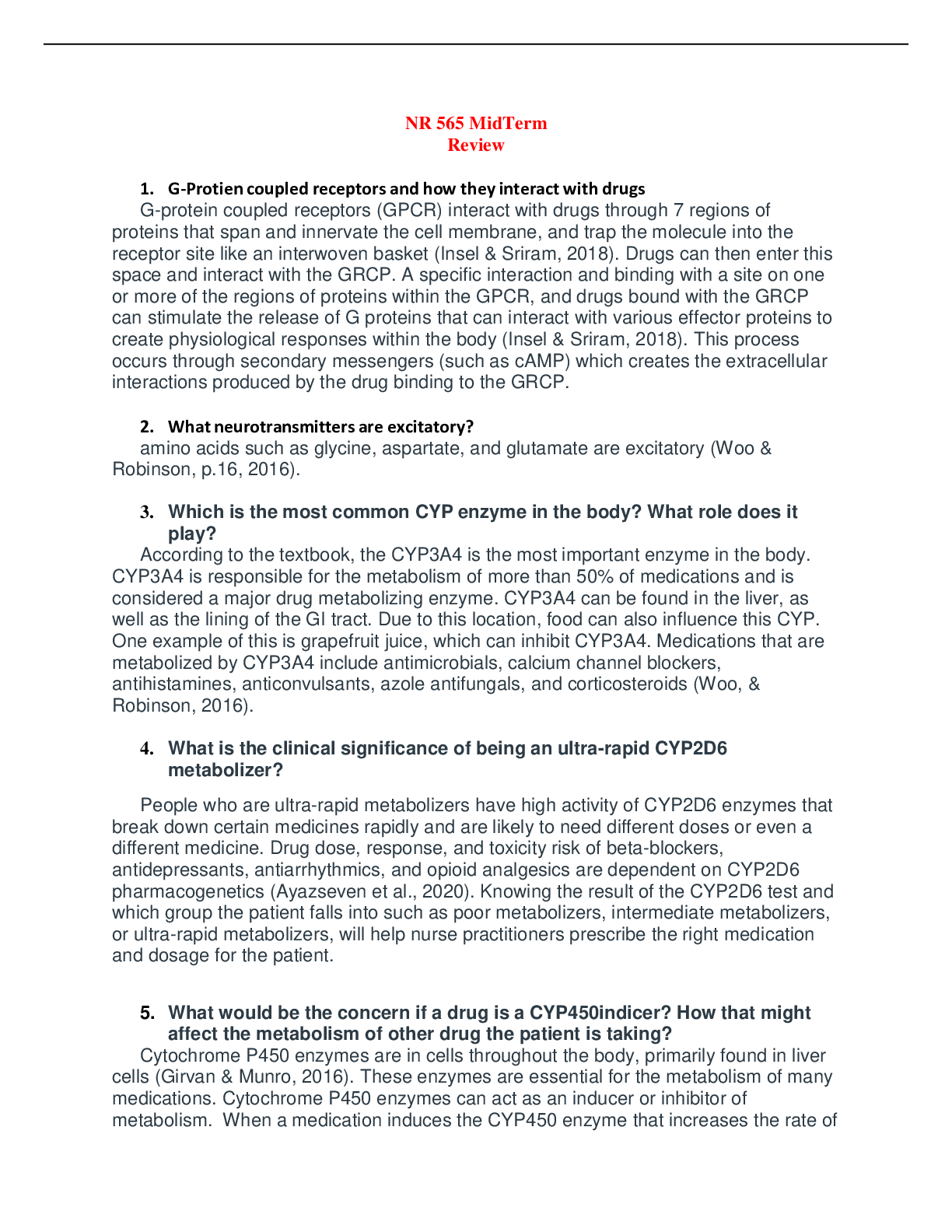






 F21.png)
